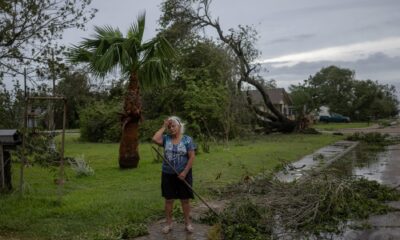Gripped by a third wave of COVID-19, Ontario is set to go into a provincewide shutdown again over the holiday weekend as climbing coronavirus cases and ICU admissions have overwhelmed hospitals.
The Thursday announcement comes ahead of a holiday weekend. The measures go into effect on Saturday and will continue for at least four weeks.
Read more:
Ontario government moves to activate 4-week, provincewide COVID-19 ’emergency brake’
The latest measures come just two months after the province had started easing COVID-19 restrictions in early February.
With hospitalizations up by 41 per cent over the past two weeks and variants of concern (VOC) responsible for 67 per cent of total cases, provincial health officials should have acted faster, some experts say.
“We’re going to go through a lot of pain and suffering and even economic harm that could have been prevented by acting earlier or by slowing down reopening,” said Jean-Paul Soucy, an infectious disease epidemiologist and PhD student at the University of Toronto.


Gerald Evans, an infectious disease specialist at Queen’s University in Kingston, Ont., said the shutdown should have been imposed “two to three weeks ago” when cases had started to climb after a plateau in dropping cases.
The COVID-19 VOC are currently driving the third wave in the province, while hospitals are seeing younger Ontarians being admitted to the intensive care unit (ICU), according to modelling released by the Ontario COVID-19 Science Advisory Table Thursday.
Read more:
Variants driving 3rd wave, younger Ontarians being admitted to ICU: modelling
The risk of ICU admission is two times higher while the risk of death is 1.5 times higher in regards to the VOC which originated in the U.K. (B.1.1.7), the report showed.
Zain Chagla, an infectious diseases physician at St. Joseph’s Healthcare in Hamilton, Ont., said the shutdown will not be enough to prevent a growth in the ICU admissions and difficult triage decisions about who gets critical care will have to be made in the weeks ahead.
“The fact is ICUs are full and unfortunately we’re seeing 2,500 cases a day … and a percentage of them are going to end up in the ICU in a few days.
“We’re obviously in a very dangerous course to limit hospital capacity, cutting down on non-COVID care.”


So, how did the province get here?
By not following the science, according to Samir Sinha, director of geriatrics at Sinai Health and University Health Network hospitals in Toronto.
Read more:
Here’s what you can and can’t do during Ontario’s COVID-19 ’emergency brake’ shutdown
“The fact that we started easing restrictions when we knew that there was a more transmissible and deadly variant around, hoping that we would actually beat this with vaccines really has shown that this was not the right strategy,” he told Global News in an interview.
The latest shutdown could have been avoided if there was enough testing, tracing, isolation and support capacity in place, Sinha said.
“We also loosened restrictions too early yet again, and we’ve seen the consequences of that as a result,” he added.
The so-called emergency brake allows for immediate action if a public health unit region experiences rapid acceleration in COVID-19 transmission or if its health-care system risks becoming overwhelmed.
Instead of blanket lockdowns, Evans said aggressive vaccination is needed to curb the spread.
“Vaccinate faster and more broadly across the population,” he said.
With regards to the vaccine rollout, Chagla said the province was not hitting the right spots.
He said that more people in communities with low transmission had been vaccinated as compared to communities with higher transmission.
“There is a supply-demand mismatch here, that the … people aren’t accessing vaccines in the areas where they need to vaccinate the most to get transmission under control.”
Equity is baked into the Ontario #COVID19 vaccination plan but must be operationalized:
1. Lower age cutoff offs for disproportionately impacted postal codes
2. More vaccine allocation to heavily impacted regions
3. Prioritizing essential workers
Link: https://t.co/LUfkeKxTds pic.twitter.com/FwX2OpgAr5
— Isaac Bogoch (@BogochIsaac) April 1, 2021
While the shutdown does buy the province some time to ease pressure on the health-care system, experts say a key area of the spread needs to be addressed for the restrictions to actually work: protect and offer support to essential workers, who continue to bear the brunt of the pandemic and are not yet up for vaccination.
“It’s not just as simple as locking down and letting things progress as they should,” Chagla said.
Soucy agreed, adding: “We’re just not seeing enough measures to address the transmission among essential workers.”
Economic toll of lockdown
Previous lockdowns and pandemic restrictions have already taken a significant economic toll on businesses across the province and country.
Small businesses on average have taken on $170,000 in COVID-19-related debt, according to a recent survey by the Canadian Federation of Independent Business (CFIB).
Three-quarters of respondents said it will take more than a year to pay it off.
Read more:
COVID-19: Ontario restaurants, small businesses demand compensation
In a statement Thursday, the CFIB called on provincial governments across Canada for alternatives to lockdowns and increased financial support for small businesses.
“It is unconscionable that over a year into the pandemic governments continue to rely almost exclusively on blanket lockdowns,” CFIB president Dan Kelly said Thursday.


The group says a survey found that two-thirds of small businesses would consider using COVID-19 rapid tests to remain open.
Ontario’s premier also faces criticism from the opposition for not imposing more restrictions faster.
Evans said the politics is putting lives at risk.
“Subject matter experts like physicians, epidemiologists, scientists like virologists are offering facts and models, which are not engaging enough for a politician focused on re-election.”
— With files from Global News’ Jessica Patton and the Canadian Press
Must See
-




Entertainment
/ 3 weeks agoFaveSzn’s Revelation: Dating Choirmaster at 10 and Sexual Curiosity
Nigerian singer, Chidozie Ugochinyere, popularly known as FaveSzn, has revealed that she once dated...
By Flying Eze -






Europe
/ 3 weeks agoWhy Hungarian Prime Minister Orban visited
Two months later, the leaders of China and Hungary met again. Hungarian Prime Minister...
By Flying Eze -






News
/ 3 weeks agoThree dead and millions without power as Tropical Storm Beryl hits Texas
Man, 53, and woman, 74, killed by fallen trees and third person drowns amid...
By Flying Eze



